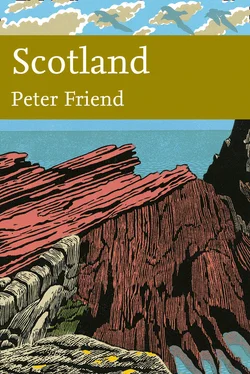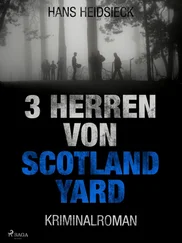By the start of the Carboniferous, around 360 million years ago, the Caledonian Mountains had been largely eroded, although the Southern Uplands still formed a considerable upland area. Throughout the following 60 million years of the Carboniferous, deposition in this Area occurred mostly in the lowlands of the Solway Firth Basin and along the border with England. Marine and coastal plain environments dominated, although varying relative sea levels resulted in the deposition of a variety of sediments, including limestones, sandstones, mudstones and coal. The Carboniferous sediments near Glencartholm, just south of Langholm ( Fig. 58), contain one of the richest Carboniferous fish faunas in Great Britain, and indeed in the world. The site is remarkable for the number of species of fish discovered, around 35, several of which are unique to the site. Some Carboniferous to Permian-aged igneous rocks are also found in this Area, generally in the form of small intrusions of coarser-grained rock.
By the end of the Carboniferous, Scotland had drifted northwards from the equator and the climate became more arid. Throughout the Permian (between 290 and 250 million years ago), red desert siltstones, sandstones and conglomerates were again deposited by winds and rivers. Fossils are not particularly common, but at Locharbriggs, just northeast of Dumfries, numerous reptile footprints have been discovered, generally heading in a southwards direction (very possibly towards the nearest source of water, in the Solway Firth Basin). The hot and arid climate of the Permian continued into the Triassic, and boulders, pebbles and sands continued to be washed and blown from the higher ground of the Southern Uplands down into sedimentary basins in the south and west of Area 2. These Triassic units tend to be mostly red, yellow and brown mottled sandstones, and comprise the Sherwood Sandstone Group. Together, both Permian and Triassic units make up the New Red Sandstone Supergroup.
In this Area, the New Red Sandstone was deposited in a series of basins, preserved in what are today the valleys of Nithsdale and the lower part of Annandale. These basins generally have a north-northwest/south-southeast trend, broadly perpendicular to the regional Caledonian trend. The Dumfries and Lochmaben basins are fault-bounded, and gravity studies suggest that Permian strata in these basins reach thicknesses of over 1000 m. They are flanked to the south by the much larger Solway Firth Basin, whose axis overlies the Iapetus Suture. The basement of this large basin is made up of tightly folded Ordovician and Silurian strata, overlain by up to 6 km of Devonian to Lower Jurassic fill.
No Mesozoic rocks are preserved in Area 2, although they would certainly have been present once: by the end of the Cretaceous, the sea had risen to cover all but the highest topography then present in this Area, and marine sediments would have been deposited during this time. However, during subsequent uplift and erosion all these younger rocks were washed away, such that during the last ~230 million years this Area has been subject to net erosion. The youngest bedrock present in this Area consists of Tertiary dykes, which despite being very small can be responsible for distinct walls in some landscapes. These dykes are long, thin intrusions of igneous rock, injected from igneous centres in western Scotland, such as Mull, around 60 million years ago.
MAKING THE LANDSCAPE
Tertiary erosion
In early Tertiary times, widespread uplift occurred across much of Scotland, particularly in the west. The Southern Uplands were again uplifted, and, in the warm, wet climate of the time, the result was vigorous weathering and erosion. As in the rest of Scotland, this weathering initiated some of the largest-scale landscape features seen today: the main upland and lowland areas became either defined or enhanced, and most of the main river valleys were initiated. Although there is not an exact correlation, bedrock has obviously played a role in determining the characteristic of the landscape – the high ground of the Southern Uplands is underlain by relatively hard Silurian strata, whilst the softer Devonian to Triassic rocks underlie generally lower ground. The bedrock of the Cheviot igneous centre has also resisted erosion, forming the Cheviot Hills ( Fig. 61).
The Southern Uplands would have been a relatively high table land at the start of the Tertiary. The subsequent erosion cut into this plateau, carving out valleys and watersheds which today define the hills. Although glacial erosion has been very important in creating the ultimate shape of the landscape, the remnants of this plateau surface are still visible in the flat or rounded hill tops, which all lie at similar elevations.
In places, weathering has clearly been concentrated along lines of geological weakness, such as faults and softer sedimentary units. The remarkably linear valley of Moffat Water, for example, coincides with a large Caledonian fault and a thin band of softer Ordovician shale. Likewise, the major valley of Annandale appears to have been eroded in the softer Permian sedimentary rocks, whilst the thin band of Silurian rocks separating the Permian of Dumfries and Lochmaben is obviously more elevated. The main rivers in Area 2 are the Tweed, Annan, Esk, Ettrick, Yarrow and Teviot, and the sources of all but the last lie in the higher hills in the northwest of the Area. Many of these rivers flow along northeast/southwest-trending valleys, parallel to the underlying folded strata, the water having taken advantage of either faults or weaker bands within the succession. Another important valley is found in the southern part of the Area: Liddesdale runs approximately northeast to southwest, with Liddel Water defining the Scottish–English boundary for several kilometres before joining the Esk. The development of this valley, too, appears to have been influenced by the underlying geology, as its location coincides with an area of heavily faulted and soft Carboniferous sedimentary rocks.
FIG 61. Digital elevation model of Area 2 with the main river valleys shown, as well as main upland areas. Sub-areas discussed in later maps are indicated by rectangles with red borders.
Evidence that the Solway Firth area acted as a basin for sedimentation in Permian and Triassic times has been outlined above. It seems very likely that it was acting as a river valley during Tertiary times.
Landscape development during the Quaternary glacials
The final form of the landscapes in Area 2, as in the rest of Scotland, owes much to the action of ice and ice meltwater. During the last 2 million years, ice sheets have repeatedly expanded to cover much of Scotland. These ice sheets flowed radially outwards from centres in the Highlands, the Southern Uplands and the Lake District, and were powerful agents of erosion and deposition.
The most recent glacial stage reached its coldest in the Late Glacial Maximum about 20,000 years ago, at which time Area 2 was overrun by Southern Uplands ice flowing roughly eastwards across the Area from an ice divide located over the outer Solway Firth ( Fig. 62). This flow is recorded by west/east-oriented drumlins along the low ground adjacent to the Solway Firth, and by a beautifully preserved array of ice-streamlined ridges along the Teviot valley. This flow direction must have been influenced by the presence of a strong ice dispersal centre in the Lake District that deflected the Southern Uplands ice to flow eastwards along the inner Solway Firth. Ice also accumulated in the Moffat Hills in the northwest of this Area, and a small but independent ice centre, powerful enough to withstand the pressure of the main ice mass, was present in the Cheviot Hills.
After the glacial maximum, the Lake District ice centre decreased in size and strength and Southern Uplands ice became dominant throughout the region. In the northeastern half of the Area, ice continued to flow roughly northeastwards down Teviotdale, but in the southwestern half, flow directions were reversed: drumlins and glacial striae indicate that ice flowed from the uplands around Moffat southwestwards down into the Solway Firth. As deglaciation continued, ice flow became valley-contained, and a final flow phase is recorded by north-northeast/south-southwest-oriented drumlins in the lowlands around the Solway Firth. Mapping of glacial deposits west of Annan and north of Gretna shows that ice then receded up the Solway Firth, as the Solway glacier retreated.
Читать дальше












